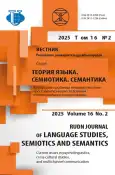Translating Onomatopoeic Words: a Comparison of Kazakh and English Languages
- Авторлар: Beibitova A.S.1, Konyratbaeva Z.M.1
-
Мекемелер:
- L.N. Gumilyov Eurasian National University
- Шығарылым: Том 16, № 2 (2025): Current issues in psycholinguistics, cross-cultural studies, and multichannel communication
- Беттер: 566-578
- Бөлім: FUNCTIONAL SEMANTICS
- URL: https://journal-vniispk.ru/2313-2299/article/view/323531
- DOI: https://doi.org/10.22363/2313-2299-2025-16-2-566-578
- EDN: https://elibrary.ru/EYTMYF
- ID: 323531
Дәйексөз келтіру
Толық мәтін
Аннотация
The study presents the problem of translating onomatopoeic words, which occupy an important place in the language and culture of the Kazakh and English peoples. Particular attention was paid to the peculiarities of the translation of onomatopoeic units from one language to another, various methods of translation, such as literal translation and equivalent translation. The discrepancy between the sound and meaning of onomatopoeic words in the Kazakh and English languages, as well as cultural and social content is given. It analyzes how onomatopoeic words influence the perception and thinking of texts in two languages and cultures. The issue of taking into account pragmatic factors by translators, such as cultural appearance and context, when transmitting onomatopoeic units has been studied. It provides useful recommendations for translators and linguists. This study explores the intricate nature of literary translation, focusing on the challenges posed by translating onomatopoeic words. It discusses how these words, which mimic sounds in language, present unique difficulties for translators due to their distinct lexical, grammatical, and phonetic characteristics. By delving into the cultural significance and origins of onomatopoeia, the paper sheds light on the complex interplay between language and sensory experience. It underscores the importance of striking a balance between fidelity to the original text and conveying the nuances of onomatopoeic expressions in literary translation.
Негізгі сөздер
Авторлар туралы
Aidana Beibitova
L.N. Gumilyov Eurasian National University
Хат алмасуға жауапты Автор.
Email: Aydana_94.18@mail.ru
ORCID iD: 0000-0002-6356-1847
Master of Arts, Doctoral student of the Department of Theory and Practice of Translation, Faculty of Philology
2 Satpayev St., Astana, Republic of Kazakhstan, 010008Zhanar Konyratbaeva
L.N. Gumilyov Eurasian National University
Email: zhanarkon2833@gmail.com
PhD in Philology, Professor of the Department of Theory and Practice of Translation, Faculty of Philology 2 Satpayev St., Astana, Republic of Kazakhstan, 010008
Әдебиет тізімі
- Tektigul, Z., Bayadilova-Altybayev, A., Sadykova, S., Iskindirova, S., Kushkimbayeva, A., & Zhumagul, D. (2023). Language is a Symbol System that Carries Culture. International Journal of Society, Culture & Language, 11(1), 203–214. https://doi.org/10.22034/ijscl.2022.562756.2781
- Koptilov, V. (1971). Stages of a translator’s work. In: Questions of the theory of literary translation (pp. 148–166.). Moscow: Khudozhestvennaya Literatura. (In Russ.).
- Komissarov, V.N., Retsker, Ya.I., & Tarkhov, V.I. (1965). A manual for translation from English into Russian: Part II. Moscow: Vysshaya shkola. (In Russ.).
- Komissarov, V.N. (1990). Translation theory (linguistic aspects). Moscow: Vysshaya shkola. (In Russ.).
- Levyi, I. (1974). The art of translation. Publisher: Progress, 398.
- Qusainov, K. (2010). Sound-visualism in the Kazakh language. Pavlodar: Toraighyrov University. 268.
- Konyratbayeva, Z., Satemirova, D., Abdualyuly, B., Kenzhalin, K., & Akazhanova, A. (2021). Eastern and Western Linguocultural Map: Similarities and Peculiarities (Based on Linguocultural Research). International Journal of Society, Culture & Language, 9(2), 85–97.
- Haywood. (2017). An analysis on onomatopoeic words and their translation procedures in Harry Potter and the Prisoner of Azkaban and its translation version. Scope Journal of English Language Teaching, 1(01), 39. https://doi.org/10.30998/scope.v1i01.870
- AlShraah, S., Aly, E., & Mohd Nasim, S. (2024). Pragmatic Realization in Exploiting Request Expressions: A Study of Language Proficiency and Social Context among Saudi EFL Learners. International Journal of Society, Culture & Language, 12(1), 412–426. https://doi.org/10.22034/ijscl.2023.2013758.3233
- Thomas, T.W. C., & Clara, C.H.W. (2004). Characteristics of Onomatopoeia: Lin 1001 Discovering Linguistics. URL: www.thomastsoi.com/ research/files/ characteristics_of_Onomatopoeia (accessed: 23.07.2024).
- Ullmann, S., & Blackwell, B. (1964). Language and Style: Collected Papers. Oxford: Blackwell.
- Hatim, B., & Munday, I. (2004). Translation: an advanced resource book. New York: Routledge.
- Ladtschenko, M. (2008). Onomatopoeic characteristics of German sound imitations. Modern research in foreign philology. Collection of scientific papers, (6), 158–163.
- Meireles, S.M. (2009). Onomatopoeic words in Japanese, German, and Portuguese: A corpus-based comparison. Journal of Linguistic Studies, 20(3), 123–145.
- Alameer, A.A. (2019). The linguistic features of onomatopoeia words in Arabic-English: contrastive Study. International Iournal of Humanities and Sotsial Stsientse Invention (IIHSSI), 8(9), 6–12. URL: https://www.researchgate.net/publication/ (accessed: 23.07.2024).
Қосымша файлдар









